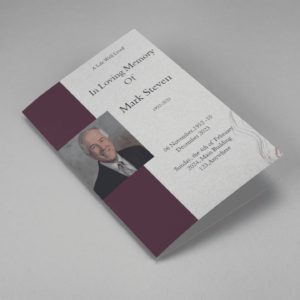A funeral resolution is a type of tribute to the deceased that is delivered as a speech, typically in church, about the deceased’s relationship with God. This type of speech warrants a serious tone and is usually delivered by a member of the clergy or pastoral staff. Each church will have specific formatting instructions although the general guidelines are similar.
Example Of A Funeral Resolution Templates
-
Searching for a White Roses And Black Ribbon Funeral Program Template that is easy to print and has a cutting-edge look? White Roses And Black Ribbon Funeral Program Template is the Perfect decision because it measures 8.5”x 11”.
- No Limitation on Content, Edit anything
- Edit anytime – unlimited revisions even after purchased
- Get a printable PDF downloaded to get it printed on your own
-
Searching for a Realistic Burning Candle Funeral Program Template that is easy to print and has a cutting-edge look? Realistic Burning Candle Funeral Program Template is the Perfect decision because it measures 8.5”x 11”.
- No Limitation on Content, Edit anything
- Edit anytime – unlimited revisions even after purchased
- Get a printable PDF downloaded to get it printed on your own
-
Searching for a Bulltongue Arrowhead Funeral Program Template that is easy to print and has a cutting-edge look? Bulltongue Arrowhead Funeral Program Template is the Perfect decision because it measures 8.5”x 11”.
- No Limitation on Content, Edit anything
- Edit anytime – unlimited revisions even after purchased
- Get a printable PDF downloaded to get it printed on your own
-
Searching for a Grey Floral White Tiny Flower Funeral Program Template that is easy to print and has a cutting-edge look? Grey Floral White Tiny Flower Funeral Program Template is the Perfect decision because it measures 8.5”x 11”.
- No Limitation on Content, Edit anything
- Edit anytime – unlimited revisions even after purchased
- Get a printable PDF downloaded to get it printed on your own
-
Searching for a Red Flower Dark Soil Funeral Program Template that is easy to print and has a cutting-edge look? Red Flower Dark Soil Funeral Program Template is the Perfect decision because it measures 8.5”x 11”.
- No Limitation on Content, Edit anything
- Edit anytime – unlimited revisions even after purchased
- Get a printable PDF downloaded to get it printed on your own
-
Searching for a Pink Rose Frame Floral Oval Badge Funeral Program Template that is easy to print and has a cutting-edge look? Pink Rose Frame Floral Oval Badge Funeral Program Template is the Perfect decision because it measures 8.5”x 11”.
- No Limitation on Content, Edit anything
- Edit anytime – unlimited revisions even after purchased
- Get a printable PDF downloaded to get it printed on your own
-
Searching for a Brown and White Classic Funeral Program Template that is easy to print and has a cutting-edge look? Brown and White Classic Funeral Program Template is the Perfect decision because it measures 8.5”x 11”.
- No Limitation on Content, Edit anything
- Edit anytime – unlimited revisions even after purchased
- Get a printable PDF downloaded to get it printed on your own
-
Searching for a Purple Elegant Watercolor Funeral Program Template that is easy to print and has a cutting-edge look? Purple Elegant Watercolor Funeral Program Template is the Perfect decision because it measures 8.5”x 11”.
- No Limitation on Content, Edit anything
- Edit anytime – unlimited revisions even after purchased
- Get a printable PDF downloaded to get it printed on your own
-
Searching for a Cream and Green Photo Obituary Program that is easy to print and has a cutting-edge look? Cream and Green Photo Obituary Program is the Perfect decision because it measures 8.5”x 11”.
- No Limitation on Content, Edit anything
- Edit anytime – unlimited revisions even after purchased
- Get a printable PDF downloaded to get it printed on your own
-
Searching for a Cream Simple Elegant Photo Church Program that is easy to print and has a cutting-edge look? Cream Simple Elegant Photo Church Program is the Perfect decision because it measures 8.5”x 11”.
- No Limitation on Content, Edit anything
- Edit anytime – unlimited revisions even after purchased
- Get a printable PDF downloaded to get it printed on your own
-
Searching for a Grey Classic Minimalist Funeral Program Template that is easy to print and has a cutting-edge look? Grey Classic Minimalist Funeral Program Template is the Perfect decision because it measures 8.5”x 11”.
- No Limitation on Content, Edit anything
- Edit anytime – unlimited revisions even after purchased
- Get a printable PDF downloaded to get it printed on your own
-
Searching for a White Classic Funeral Program Template that is easy to print and has a cutting-edge look? White Classic Funeral Program Template is the Perfect decision because it measures 8.5”x 11”.
- No Limitation on Content, Edit anything
- Edit anytime – unlimited revisions even after purchased
- Get a printable PDF downloaded to get it printed on your own
-
Searching for a Cream Gold Marble Funeral Program Template that is easy to print and has a cutting-edge look? Cream Gold Marble Funeral Program Template is the Perfect decision because it measures 8.5”x 11”.
- No Limitation on Content, Edit anything
- Edit anytime – unlimited revisions even after purchased
- Get a printable PDF downloaded to get it printed on your own
-
Searching for an Elegant Beige Funeral Program Template that is easy to print and has a cutting-edge look? Elegant Beige Funeral Program Template is the Perfect decision because is has a measure of 8.5”x 11”.
- No Limitation on Content, Edit anything
- Edit anytime – unlimited revisions even after purchased
- Get a printable PDF downloaded to get it printed on your own
-
Searching for a White Floral Pro Funeral Program Template that is easy to print and has a cutting-edge look? White Floral Pro Funeral Program Template is the Perfect decision because is has a measure of 8.5”x 11”.
- No Limitation on Content, Edit anything
- Edit anytime – unlimited revisions even after purchased
- Get a printable PDF downloaded to get it printed on your own
-
Searching for a Grey and Burgundy Elegant Funeral Program Template that is easy to print and has a cutting-edge look? Grey and Burgundy Elegant Funeral Program Template is the Perfect decision because is has a measure of 8.5”x 11”.
- No Limitation on Content, Edit anything
- Edit anytime – unlimited revisions even after purchased
- Get a printable PDF downloaded to get it printed on your own
-
Searching for a Creative Watercolor Floral Funeral Program Template that is easy to print and has a cutting-edge look? Creative Watercolor Floral Funeral Program Template is the Perfect decision because is has a measure of 8.5”x 11”.
- No Limitation on Content, Edit anything
- Edit anytime – unlimited revisions even after purchased
- Get a printable PDF downloaded to get it printed on your own
-
Searching for a Soft Green and Grey Minimalist Floral Funeral Program Template that is easy to print and has a cutting-edge look?Soft Green and Grey Minimalist Floral Funeral Program Template is the Perfect decision because is has a measure of 8.5”x 11”.
- No Limitation on Content, Edit anything
- Edit anytime – unlimited revisions even after purchased
- Get a printable PDF downloaded to get it printed on your own
-
Searching for a Green Natural Funeral Program Template that is easy to print and has a cutting-edge look? Green Natural Funeral Program Template is the Perfect decision because is has a measure of 8.5”x 11”.
- No Limitation on Content, Edit anything
- Edit anytime – unlimited revisions even after purchased
- Get a printable PDF downloaded to get it printed on your own
Eulogy vs Funeral Resolution
Funeral resolutions are often confused with eulogies as they are both typically read at funerals. A eulogy is much more light-hearted and typically involves stories, anecdotes, and memories of life with the deceased. This type of speech is usually written and read by a close friend or family member.
A funeral resolution on the other hand, is serious in tone, follows a specific format and becomes official church documents that will be saved in the church’s archives. Funeral resolutions are typically for members of a church, however, many large organizations and companies choose to honor members and employees with funeral resolutions as a way of expressing gratitude and acknowledging service.
Parts of a Funeral Resolution
Funeral resolutions usually consist of five parts and should not be longer than two pages. You will need to include a title, introduction, whereas statements, resolutions, and the official statement.
Title
The title of the resolution is typically centered at the top of the first page, consists of one line, and includes the full name of the deceased. Phrases such as ‘Resolution of Respect’ or ‘Resolution in Loving Memory’ followed by the name of the deceased are common titles.
Example: Resolution of Respect for Dr. Ann Marie Smith
Introduction
The introduction, like the title, is made up of one line. This section is also commonly referred to as the Introduction of Faith. The purpose here is to acknowledge the deceased’s close relationship with God as well as his or her passing. Some people choose to include a funeral poem or passage from the Bible in this section as well. A few questions to ask before writing the introduction are:
- What was the deceased’s relationship with God like?
- Did the deceased have a favorite Bible verse?
When writing the introduction, you should use eloquent language to convey that the deceased is now with God.
Example: Almighty God has chosen, with His infinite wisdom, to call our beloved Dr. Ann Marie Smith to join Him in heaven. Mark 10:14 says, ‘Let the little children come to me; do not stop them; for it is to such as these that the kingdom of God belongs.’
Whereas Statements
This section explains the reasons for the funeral resolution. The name of the section comes from the fact that all the statements included should begin with the word ‘whereas.’ The American Library Association points out that these statements are not a biography and typically do not include any specific dates. Some questions to ask before writing include:
- How many years was the deceased an active member of this church (or organization)?
- What is the legal name of the church?
- Were there any specific programs or projects with which the deceased worked closely within this church?
- Was the deceased married at the time of death, or did he or she have a significant partner at the time?
- How was the deceased beloved by the community?
- What were the most significant accomplishments of his or her life?
Each statement should explain one of the following:
- The deceased’s relationship with God
- Specific work for the church (such as a particular program)
- Support to the family
- How the deceased was loved by the community
Breakdown of Statements
The ALA suggests the following breakdown of statements:
-
One about general loss to a specific organization or church.
Example: Whereas the United Church of Town lost a valuable member in the death of Ann Smith, she will be remembered fondly for all time.
-
One or more regarding particular interests in that community.
Example: Whereas Ann Smith was a beloved Bible study and youth group leader for 15 years.
-
One or more briefly describing long-term or significant employment (including number of years of service).
Example: Whereas countless students were inspired by her community service projects as the Home Economics teacher for 25 years.
-
One or more about local activities and interests not related to the church or organization.
Example: Whereas Mrs. Smith proudly served as the Town School Board President for eight years.
-
End with one statement detailing positive personal characteristics of the deceased, using his or her full name.
Example: Whereas the kindness, empathy, humor, and hospitality of Ann Marie Smith enhanced the lives of all fortunate enough to know her.
Resolutions
This section is also sometimes referred to as ‘Therefore Statements’ because they generally begin with the words, ‘Therefore let it be resolved…’. The resolutions section should be shorter than the whereas statements, with one or two lines as the standard. Resolutions offer details as to who will be involved and how, when, or where. It is best to ask church officials or family members in what way they would like the congregation to resolve the death of the deceased.
Resolutions may include acts such as an observed period of mourning or the displaying of the deceased’s picture. Organizations, like ALA, suggest that the first resolution should recognize the deceased’s contributions to the organization while the second can express sympathy for the loss.
Example: Therefore be it resolved that we recognize the remarkable achievements of Dr. Ann Marie Smith and show our love and support to the family as we mourn her death together.
Be it further resolved that an official period of mourning be observed for 30 days by the lighting of a candle every day in the church sanctuary in her memory.
Official Statement
The final section of the funeral resolution is also referred to as the Acknowledgment or Proclamation. This is also an appropriate time to include a funeral poem or Scripture. The official statement is meant to bring closure to a person’s passing and offer encouragement to the family.
Example: The United Church of Town offers its sincerest condolences to those loved by Dr. Smith. (insert Bible verse or funeral poem)
This statement typically ends with the words, ‘humbly (or respectfully) submitted.’ The main church officers would then sign the entire document.
Resolving the Death of a Loved One
A funeral resolution is a great way to honor the spiritual life of a beloved community member. If you follow the standard format and guidelines offered by the church you are sure to create a memorable funeral tribute.




















